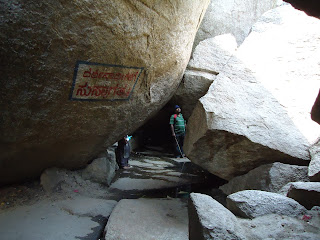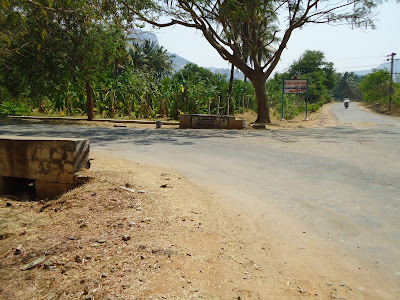We were shown the Shiva Linga and is called Siddeshwara. It is a tiny black linga with a hooded serpent of metal. It was adorned with flower garlands and other assorted flowers like hibiscus. After a brief prayer we decided to venture deeper into the cave.
 |
| Rugged Path to Rudra Muneeshwar Gaduge |
 |
| Low roofed caves to be negotiated |
 |
| Jeevantha Samadhi (Live grave) of Venkatappa Avadhutha |
All the fotos that I have put in the blog are from a still camera with a flash. A video camera recording would have been quite spectacular. I provide a link to a video recording further below.
 |
| Meditating on Rudramuneeshwara Gaduge (Seat) |
I sat on the Rudra Muneeshwara Gaduge and meditated for a few minutes. Later we explored a small underground source of refreshingly cold sweet water just beside the Gaduge. This spring is called Suvarnagundi as the hill is also known as Suvarnagiri. Vinod asked me if I was game to have a bath in that water. When I eagerly assented (I had brought a spare underwear and towel from Bangalore based on my readings of other blogs) he made me sit on a rock about five feet away, fetched a vessel and poured out five large measures of water on my head.
 |
| The spring named Suvarna Gundi |
 |
| Jyoteshwar Das - the Nepali Sadhak in the cave at Siddarabetta |
He said he had acquired some power over his bodily needs through intense sadhana. He said that though all these local villagers were saying that he had not eaten for five days, he had a meager stock of beaten rice (poha in Hindi) with which he was feeding himself somewhat. He later informed us that he was getting intuitive messages that his friend was in some need and that he had to leave for Tumkur immediately. Presently Karthik, Jyoteshwar Das and I descended to the foot of the hill after paying our guide Vinod a small sum of 300 rupees for his guidance.
We reached the base at 3:50 p.m and left for Bangalore at 4:10 p.m. The speedometer reading was 83115 at Siddarabetta. This time we headed towards Tumbadi and Koratagere and thence to Dobbspet and Bangalore. We had a break of about 50 minutes at Uradigere where Karthik wanted to buy fresh vegetables. It is only after we entered the Bangalore Division from the Tumkur Division on
SH3 that we found the quality of the road to be good. The other drawback on this route is that there are quite a lot of dangerous curves and the route is rather sinuous. Further, as is the tendency of many rural folk especially in Karnataka there are many unmarked badly constructed speedbreakers that can be quite dangerous to a motorbike rider. The route we had taken in the morning had none of these flaws and we had a safe ride. On our return journey we were at Yeshwantpur, Bangalore at 7:10 p.m. and reached Rajajinagar (Karthik's house) at 7:30 p.m. The kilometer reading at home was 83218 meaning that it had taken us 103 km on a return journey.
For an interesting short video on exploring the caves at Siddarabetta click on the Youtube link given below: (be sure to connect your speakers !)
http://www.youtube.com/watch?v=oqla6BlT-xw&feature=colike
Thus ended an exhilarating Sunday in the month of March 2012 !
Concluded


















